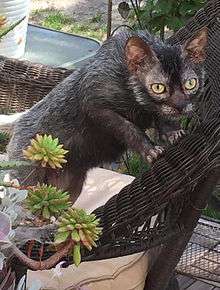Lykoi
| Lykoi | |
|---|---|
 | |
| Common nicknames | Werewolf cat, wolf cat |
| Origin | United States |
| Breed standards | |
| TICA | standard |
| Notes | |
|
Not eligible for TICA champion status; classified as "Advanced New Breed". | |
| Domestic cat (Felis catus) | |
The Lykoi is a natural mutation from a domestic shorthair that has the appearance of a werewolf. The mutation has occurred in domestic cats over the last 20 years. DNA testing has been done by UC Davis to confirm that the cats do not carry the Sphynx/Devon gene. The Lykoi breed was developed in Vonore, Tennessee and is said to resemble a werewolf. The word "lykoi" means 'wolves' in Greek.[1]
Characteristics
The Lykoi is a partially or almost entirely hairless cat that is genetically distinct from the Canadian Sphynx. The hair coat is unique in appearance in that it resembles the coat of an opossum when mostly coated. Standards call for a solid black roan coat, a wedge-shaped head, and a lithe body of solid weight without excessive bulk. Lykoi are said to be friendly and unchallenging in their behavior. They display a high level of affection for their owners.[2]
A unique characteristic of the cat breed is that the Lykoi sheds a lot when older but regrows its hair later in life depending on the season.[3]
The missing coat of the Lykoi's face gives the breed a werewolfish appearance.[4]
History of the cat breed
Two different sets of domestic shorthairs with the Lykoi gene were adopted from a rescue after being discovered in Virginia in 2010, by Patti Thomas, who co-founded and named the breed, and in 2011, a second pair were located in Tennessee, by Johnny Gobble. [5] [6]
The Lykoi went before The International Cat Association (TICA) registry in 2012 and was passed to "Registration Only" status by unanimous consent. The breed is now recognized as a Championship Breed and can begin competing against other Championship breeds in May 2017, with TICA.[7] Work is currently being done to expand the breeding program.[5]
Controversy
The Lykoi is not a designer breed, but many designer breeds have engendered controversy.[8] The Cat Fanciers' Association (CFA), specifies a number of "Requirements for Recognition as a Provisional Breed".[9] As of November 2015, the Lykoi was not recognized by the CFA even as a provisional breed, but is recognized as an Advanced New Breed with The International Cat Association.[10]
Coat
At the University of Tennessee, dermatologists examined them for any skin abnormalities. Along with biopsy samples of the skin, the dermatologists could find no reason for the coat pattern. What they did find is that some hair follicles lacked all the necessary components required to create hair (which is why Lykoi lack an undercoat). They also found that the follicles that were able to produce hair lacked the proper balance of these components to maintain the hair (which is why Lykoi do moult and can become almost completely bald from time to time). It was determined, with test breeding, to be true natural mutation.[1]
External links
References
- 1 2 "History | Lykoi Cats ~ The Original Lykoi Breeder". lykoikitten.com. Retrieved 2016-06-09.
- ↑ "That's one freaky feline! Breeders develop a CAT that looks like a WEREWOLF and acts like a DOG". Daily Mail. 2014-02-11. Retrieved 2014-03-23.
- ↑ Supan, Colleen. "Meet the Werewolf Cat: the Lykoi". Catchannel.com. Retrieved 2015-11-11.
- ↑ "Lykoi cats have a DNA mutation that makes them look like werewolves - Tech Insider". Techinsider.io. 2015-10-27. Retrieved 2015-11-11.
- 1 2 "Lykoi Breed History". lykoicat.com. Retrieved 2014-03-23.
- ↑ http://nextshark.com/theres-a-terrifying-breed-of-werewolf-cats-that-act-like-dogs-and-cost-up-to-2500/
- ↑ "TICA Breeds - savannah cats, bengal cats, maine coon cats, maine coon kittens, savannah kittens, bengal kittens, persian kittens, persian cats, breeds of kittens, breeds of cats". Tica.org. Retrieved 2015-11-11.
- ↑ Bird, Susan (February 20, 2014). "The 'Werewolf Cat' Is Everything That's Wrong With Designer Breeds". Care2. Retrieved November 11, 2015.
- ↑ "New Breeds and Colors". Cfa.org. Retrieved 2015-11-11.
- ↑ "Cat Fanciers Association : Breeds". Cfa.org. Retrieved 2015-11-11.